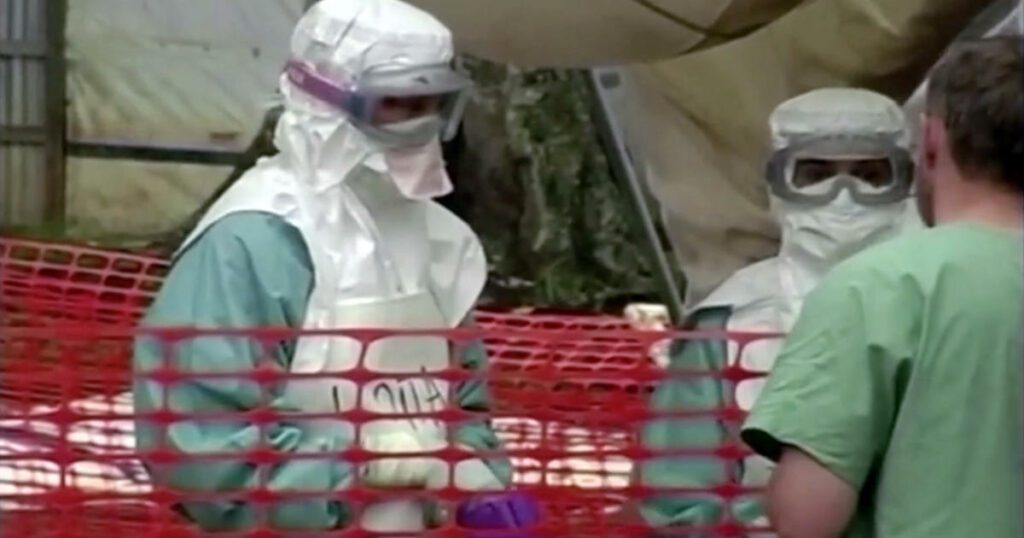The Centers for Disease Control and Prevention warned doctors Thursday to be aware of two growing outbreaks of Marburg virus disease in Africa, and will begin reaching out to some arriving travelers to the U.S. to watch for symptoms of the Ebola-like viral hemorrhagic fever.
This new CDC alert comes as cases have climbed in the wake of Equatorial Guinea and Tanzania declaring outbreaks of Marburg earlier this year. The outbreak is the first declared for each country, and ranks as among the largest on the continent in a decade.
“Currently, the risk of MVD [Marburg virus disease] in the United States is low; however, clinicians should be aware of the potential for imported cases. It is important to systematically assess patients for the possibility of viral hemorrhagic fevers,” the CDC’s alert urges.
What is Marburg virus, and what are the symptoms?
Marburg is a virus that can infect humans who come into contact with its animal host, a type of bats native to Africa. It can then be transmitted from an infected person to others through contact with blood or bodily fluids.
Click here to view related media.
click to expand
Similar to its close relative Ebola, Marburg begins with common symptoms like fever and headaches before progressing to increasingly severe issues like diarrhea, “massive hemorrhaging” and organ failure. Around half of patients with identified cases die in outbreaks, on average, the World Health Organization estimates.
Symptoms can begin as early as two days after exposure to as late as three weeks after.
So far, local authorities have tallied 14 confirmed cases in Equatorial Guinea since the outbreak was declared on February 13, with 10 dead. An additional 23 probable cases have been identified, the WHO said Thursday.
The CDC says eight cases have been confirmed in Tanzania, with five dead.
Most experts think the two outbreaks stemmed from separate so-called “spillover events” from animals to humans, the CDC says.
Authorities have warned that cases in Equatorial Guinea have been detected across a wide swath of the country with no known links between patients, suggesting that the virus is spreading undetected among people in the region.
“Though we do not know yet the origin of the Marburg outbreaks in Equatorial Guinea and Tanzania, we do know that there continues to be increased capacity in Africa to recognize and test samples for viral haemorrhagic fevers like Marburg and Ebola,” the World Health Organization’s Dr. Tieble Traore said April 4 in a post.
Travel and other precautions
There are no direct flights from either country to the U.S. However, the CDC says it has begun sending text messages to arriving travelers who had been in Equatorial Guinea or Tanzania, urging them to contact authorities if they develop Marburg symptoms within 21 days after their trip.
“Currently, no enhanced domestic travel measures are recommended, as the overall risk in the United States is considered low at this time,” the CDC’s alert says.
The agency says it is also working with nongovernmental organizations in the areas with guidance echoing their Ebola recommendations for avoiding infections and screening workers after they return. The CDC has previously been updating its guidance for Ebola to include Marburg as well, in addition to stepping up its travel alert over the outbreak.
In Tanzania, the White House says the U.S. has been providing personal protective equipment as well as “technical support in epidemic management.”
In Equatorial Guinea, CDC responders first began deploying in the wake of the outbreak being declared in February. The U.S. laboratory was stood up on March 10, and is now training local authorities to diagnose suspected cases of Marburg.
Work on possible vaccines
There are no approved vaccines or treatments for Marburg, although manufacturers of several potential vaccine candidates – including one U.S. government-backed option from the Sabin Vaccine Institute – have readied some experimental shots that could be deployed.
750 doses from that vaccine, based on a chimpanzee adenovirus, are ready to be deployed in trials for the current outbreak. WHO officials have previously said shots may be administered in a “ring” approach around the contacts of each case who are at-risk in hopes of helping to stem transmission.
The WHO said Thursday that there is no agreed-upon date for when the country will greenlight test vaccinations to begin, but that Equatorial Guinea has cleared visas for its experts to arrive ahead of shots potentially going into arms.
“When the conditions may be favorable, the trials may be initiated. So right now is building the basics of good alert management and case management and other basics of the outbreak response. And at a future date may be considered, but as of now, we don’t have a firm date for when it will start,” the WHO’s Dr. Abdi Mahamud told reporters.
More from CBS News
Alexander Tin
Source link : https://www.cbsnews.com/amp/news/marburg-virus-cdc-alert-travelers/
Author :
Publish date : 2023-04-06 07:00:00
Copyright for syndicated content belongs to the linked Source.
